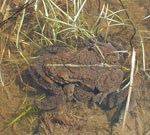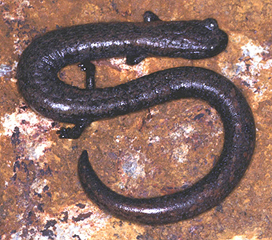- Home
- About S&T
- Taxa/Organisms
- Ecosystems
- Issues
- Methods & Tools
- Reports & Publications
- Location
- Search
Publisher: USGS | Science Center: Forest and Rangeland Ecosystem Science Center (FRESC, Corvallis) | Format: URL
fresc.usgs.gov — Prescribed fire and forest thinning is a management strategy that promotes the development of forest structure and composition similar to that present under a native fire regime. This research summary describes how FRESC researchers will address the effects of prescribed fire and forest thinning on the diversity, abundance, and habitat More...

Publisher: USGS | Science Center: Western Ecological Research Center (WERC, Sacramento) | Format: URL
www.werc.usgs.gov — Native amphibian and reptile populations worldwide are under threat from exotic invasive species of plants and animals, including other reptiles and amphibians. As habitats are changed and plant community organization is modified by exotic species, delicate relationships between plants and animals are altered or eliminated, creating a negative More...

Publisher: USGS | Science Center: Patuxent Wildlife Research Center (PWRC, Laurel) | Format: URL
www.pwrc.usgs.gov — Amphibian Research and Monitoring Initiative (ARMI) is designed to determine where populations of amphibians are present, to monitor specific Apex populations, and to investigate potential causes of amphibian declines, diseases, and malformations. The Northeast Region of ARMI encompasses thirteen states (Connecticut, Delaware, Maine, Maryland, More...

Publisher: USGS | Science Center: Fort Collins Science Center (FORT, Ft. Collins) | Format: URL
www.fort.usgs.gov — The boreal toad (Bufo boreas) is rare over much of its range and declines have been documented or are suspected in many areas of the West, including the northern Rocky Mountains. This issue overview evaluates the hypothesis that fire suppression and exclusion could cause decline of the boreal toad (Bufo boreas) in the northern Rocky Mountains.

Publisher: USGS | Science Center: Forest and Rangeland Ecosystem Science Center (FRESC, Corvallis) | Format: URL
fresc.usgs.gov — Molecular genetic methods are being used to assess population differentiation for a number of salamanders listed as species of concern in the Northwest Forest Management Plan: the Oregon slender salamander, Larch Mountain salamander, southern torrent salamander, Cascade torrent salamander, Columbia torrent salamander, and Olympic torrent More...

Publisher: USGS | Science Center: Patuxent Wildlife Research Center (PWRC, Laurel) | Format: URL
www.pwrc.usgs.gov — Written summaries of biological characteristics and contaminant exposure and effects data for 38 coastal and estuarine terrestrial vertebrates are available. Species were selected based on their previous use in contaminant monitoring, their status as valued natural resources, or as representatives of taxonomic groups. Characterizations were More...

Publisher: USGS | Science Center: Fort Collins Science Center (FORT, Ft. Collins) | Format: URL
www.fort.usgs.gov — At high elevations, and in the nearby Capitan and White mountains in alpine tundra habitat, the Sacramento Mountain salamander occurs. This issue overview looks at size-class distributions of salamanders, showing that juveniles comprise a significantly smaller proportion of all salamanders on logged plots, suggesting that populations on logged More...

Publisher: USGS | Science Center: Forest and Rangeland Ecosystem Science Center (FRESC, Corvallis) | Format: URL
fresc.usgs.gov — The National Park Service has stated that declining amphibian populations are the top priority for research in the National Park System. Salamanders are a native vertebrate predator in small, western, high-mountain lakes naturally barren of fish. During this century many western high-mountain lakes were stocked with trout. These introduced fish More...

Publisher: USGS | Science Center: Forest and Rangeland Ecosystem Science Center (FRESC, Corvallis) | Format: URL
fresc.usgs.gov — Description of a project to determine the status of reptiles and amphibians at Olympic National Park. Includes project objectives, metadata, related publications, and contact information.

Publisher: USGS | Science Center: Forest and Rangeland Ecosystem Science Center (FRESC, Corvallis) | Format: URL
fresc.usgs.gov — There is a relatively rich herpetofauna in southwestern Oregon with about 38 species present. These species are almost equally divided between amphibians and reptiles. The objective of this issue overview is to conduct field surveys and assess status of several amphibian species of management concern, including: Western toad (Bufo boreas), Cascade More...

Publisher: USGS | Format: URL
pubs.usgs.gov — The steps necessary to conduct a pitfall trapping survey for small terrestrial vertebrates are presented. Descriptions of the materials needed and the methods to build trapping equipment from raw materials are discussed. Recommended data collection techniques are given along with suggested data fields. Animal specimen processing procedures, More...

Publisher: USGS | Science Center: Western Ecological Research Center (WERC, Sacramento) | Format: URL
www.werc.usgs.gov — This site is a field guide to the reptiles and amphibians of coastal Southern California, including species accounts, illustrations of tadpoles, and images of different habitat types. The guide also contains a glossary of terms, a map of the study area, and types of habitats.
